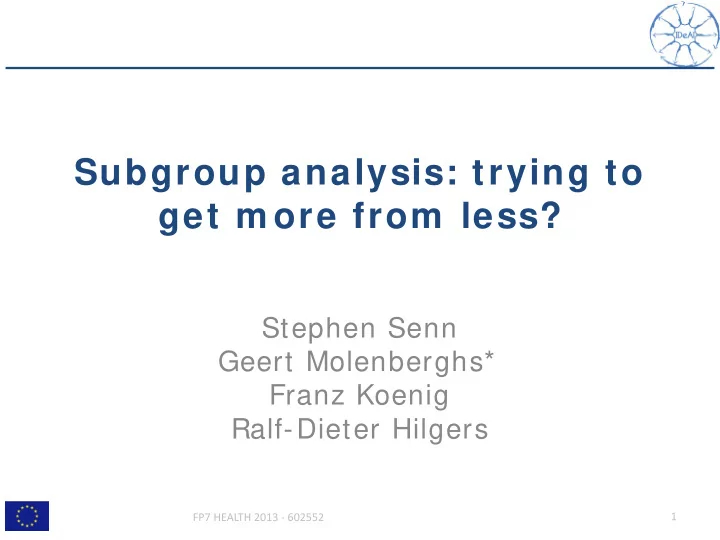

Subgroup analysis: trying to get m ore from less? Stephen Senn Geert Molenberghs* Franz Koenig Ralf-Dieter Hilgers FP7 HEALTH 2013 - 602552 1
Consider this trial Insert Text This is a perfectly behaved trial. The point estimate is identical for the two groups and the overall P-value is 0.01. Despite that, it is impossible for the P-value in both groups to be less than 0.05. FP7 HEALTH 2013 - 602552 2
I nsert Title Insert Text 80% power overall In each sub-group the true treatment effect is identically equal to the clinically relevant difference FP7 HEALTH 2013 - 602552 3
Practical Considerations There is an opportunity cost in pursuing proof of sub-group benefit Trials would have to larger Proving effects in subgroups would then compete for patients and finance with other drug development programmes The question is as to whether this is a sensible use of resources In many cases the priorities, for society, patients and sponsors would be to research new treatments rather than dot the “i”s and cross the “t”s of existing ones FP7 HEALTH 2013 - 602552 4
Tw o extrem e different sub-group cases A few large Many sm all subgroups subgroups Fixed effect approaches It may be possible to would be the norm analyse these using a random effects model – For example, testing treatment by sub-group Some general impression interaction of variability between subgroups may be However, expectations, of obtained what can be shown should be small Does this exceed chance levels? Proof of efficacy by subgroup not realistic FP7 HEALTH 2013 - 602552 5
31 Placebo-Controlled Trials of Cimetidine 4 3 log-odds ratio 2 1 0 Significant (Yates) Not-significant -1 Upper control limit Lower control limit significance boundary -2 0.0 0.4 0.8 1.2 standard error FP7 HEALTH 2013 - 602552 6
Tw o different cases in drug developm ent A substantial Non-inferiority average benefit is ( only) is show n proven Here there is not necessarily any great loss It would be illogical to in patients continuing to require efficacy in use existing therapy subgroups for registration Further regulatory To do so would require assurance that certain future patients to take an groups of patients would existing treatment that not lose by switching was on average worse, might be reasonable simply because the new treatment had not been shown to be of benefit to all FP7 HEALTH 2013 - 602552 7
Conclusion Failure to provide convincing proof of efficacy in subgroups is the norm Clinical trials would have to be much larger for this not to be the case Furthermore, as the number of possible sub- groups increases the probability of a spurious ‘effect-reversal’ increases It is necessary to be realistic and modest in one’s ambitions Regulators should not demand and should not generally expect proof of efficacy in sub-groups The priorities in drug-development lie elsewhere This project has received funding from the European Union’s 7 th Framework Programme FP7 HEALTH 2013 - 602552 8 for research, technological development and demonstration under Grant Agreement no 602552
Recommend
More recommend